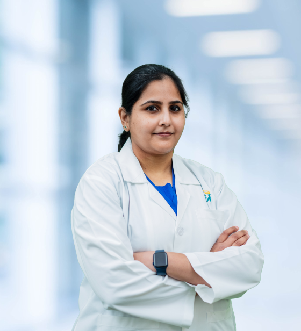Paediatric Cancer - Overview
Paedriatic cancers are types of cancers that occur in children and young adults aged up to fourteen years. The type of cancers that develop in newborn and young adults, their signs, symptoms, diagnostic measures and treatment methods may vary from adults and thus, need specialised attention.
Types of Paediatric Cancer
Sarcomas, Leukaemia, brain and spinal cord tumours, Neuroblastoma, Wilms tumour, lymphoma, Retinoblastoma, and bone cancer are some of the most common cancer variants in children and young adults.
Some of the other common cancers impacting the younger population are:
- Breast cancer
- Lymphomas (non-Hodgkin and Hodgkin)
- Melanoma
- Cancers of the female genital tract (cervix and ovary)
- Head and Neck Cancers
These variants of paediatric cancers may emerge at different times, in different age groups and may exhibit varying degrees of symptoms and complications. Watching out for any potential signs and symptoms is highly recommended.
Signs & Symptoms of Paediatric Cancers
Identifying cancer in children and young adults is often very difficult as the symptoms are similar to common illnesses. It is recommended for parents and caregivers to opt for periodic health check-ups to ensure that the diagnosis happens on time. It is also recommended not to self diagnose or confuse the signs and symptoms with other common health ailments
Some of the common symptoms of paediatric cancer in children are:
- Unusual lump or swelling in the body
- Unusual fever or illness, or loss of energy
- Frequent vomiting and headaches
- Sudden changes in the vision
- Uncharacteristic weight loss
- Constant tiredness and paleness
- Frequent infections
- Painful joints and muscles
- An abnormally large head
- Delayed developmental milestones
Most of the above symptoms can also be experienced because of other infections or illnesses. Depending on the type and area of cancer being developed, there might be other symptoms that a child can experience.
Paedriatic Cancer Diagnostics and Treatment
The diagnosis of paediatric cancer consists of different tests. The following factors will be considered while choosing a diagnostic test.
- The type of cancer
- Child’s age and overall health
- Signs and symptoms
- Results of previous medical tests
Based on these factors, the medical professional will diagnose further and can also prescribe the following tests.
- Blood tests to identify the presence of various cells in the blood.
- Biopsy to examine a certain tissue under the microscope.
- Imaging tests like CT scans or MRI scans ensure the accuracy and precision of the treatment.
The treatment of paediatric cancer will include various options like Surgery, Systemtic Therapy (Chemotherapy/Immunotherapy), Radiation therapy. It can be a single treatment method or a combination of multiple therapies.
Little bit about Radiation Therapy
Proton therapy is the most advanced form of radiation therapy with relatively less side effects and higher chances of success and recovery. It helps limit radiation exposure to a constrained area. Therefore, the impact on the nearby normal tissue is minimal. Not only does this help the children with effective treatment, but it also provides a better quality of life. Proton therapy on paediatric brain tumours, neck, lungs, heart, and other areas can benefit children extensively.
Advantages of Proton Therapy for Children
The precise delivery of radiation to the affected area makes paediatric proton therapy one of the best solutions. It is an effective treatment method for many childhood cancers, including lymphomas, tumours on different parts, sarcomas, and others. It is often used along with other treatment methods like surgery and/or chemotherapy to get the best possible results. Some of the key benefits associated with proton therapy for paediatric cancer are:
- Proven results in children and young adults
- Proton therapy causes fewer side effects on children as compared to other conventional treatments
- Reduced risk of the impact of radiation on the surrounding otherwise healthy tissues
- Better quality of life and normal growth of children
- Fewer chances of secondary tumours development and recurrence due to exposure to radiation
- Potential to increase the radiation dose based on the requirement
How Proton Therapy Works?
Proton beam therapy in paediatric oncology uses charged particles to deliver a high radiation dose directly to the tumour. Not only does this help in the precise impact on cancer, but it also reduces the impact on other nearby vital organs. X-rays release their energy both before and after the effect on the tumour. But proton therapy releases the energy only after hitting the tumour, making it safer.
Another significant advantage that makes proton therapy safer is that it reduces the chances of secondary tumours in the future. Children have growing bodies; thus, it is necessary to cure existing cancer and ensure the future. Therefore, proton therapy reduces the probability of children having cancer in the future.
Is Proton Therapy Safe for Children?
Since proton therapy targets cancer cells with higher precision, it is an excellent treatment method for children. In addition, it is a powerful and safer alternative to other traditional forms of radiation. However, when it comes to children, doctors often shy away from using radiation therapy on them. This is because children have a developing sensitive body and thus need the highest care.
How can patients prepare for proton therapy for paediatric cancer?
After the tests and diagnosis, as the cancer care team finalises proton therapy as the treatment method for paediatric cancer, they first take the patient through a simulation and imaging test to ensure that the radiation hits the right areas. While planning to undergo proton therapy for paediatric cancer, below are a few things to remember.
- Get the details of the treatment process while asking the oncologists and the cancer care team the necessary questions. Ask about the treatment process, including the number of sessions required and what to expect during each session.
- Ask about the potential side effects that the treatment can have and how they can be managed.
- Ensure you follow the treatment plan while taking the necessary medications and attending the scheduled appointments.
- Maintain your health by eating healthy and working out regularly. The nutrition team at APCC can help with the food and workout plans.
- Seek help wherever required, including transportation, childcare, or other tasks throughout the treatment.
- When you have concerns, ensure you raise them with the team without hesitation.
Which Paedriatic Cancer Patients Benefit From Proton Therapy?
Paedriatic cancer patients can benefit from proton therapy in several cases. While several factors like a patient’s age, location of the tumour, stage of cancer, and others can impact the efficacy, children with tumours in their head, neck, spine, lungs, heart, or other sensitive areas can reap the benefits of proton therapy. It helps in limiting the possible damage to kids whose bodies are still in a developing stage.
What Can Patients Expect from Proton Therapy for Paediatric Cancers?
The patient should know that the therapy can continue for 6 to 8 weeks. It can even continue further depending on the condition and the severity of the illness. The visit can last between 30 minutes to one hour. Most of the time is spent getting the child ready in the correct position for the therapy. Ensuring that the proper place is identified during the simulation is vital. It helps make the child feel comfortable and maximises therapy's impact.
The therapy is painless and doesn't require the patient to stay in the hospital. However, children under six years might be subjected to anaesthesia to keep them still.
What is the Cost of Proton Therapy for Paediatric Cancer?
The cost of the complete treatment might vary on an individual case basis. Many factors need to be considered while estimating the overall cost of the therapy. The patient's current condition and other health parameters are essential in determining the necessary treatment. If the cancer is diagnosed early, the cost might be relatively lesser.
Since proton therapy uses high-end technology and dedicated skills, the cost is comparatively more.






.jpg)




